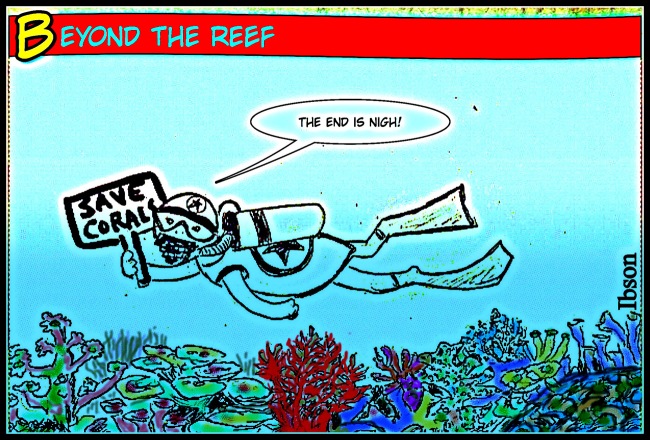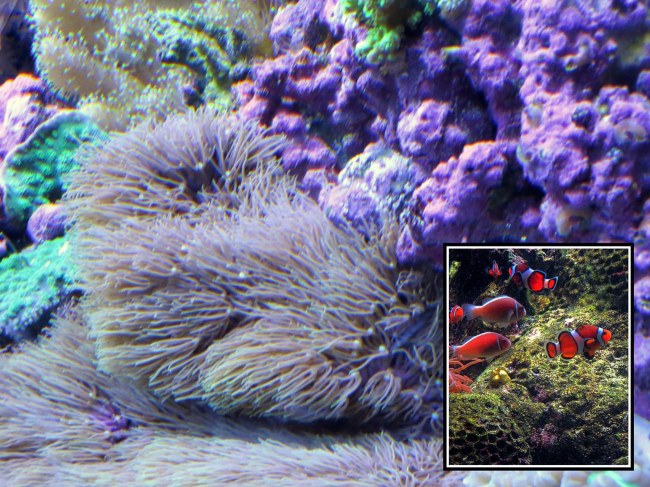The many splendoured coral reefs are under serious threat.
Already over half of the earth’s fabled reefs indisputably known as the ‘rainforests of the ocean’ have been destroyed . In the the past three decades that is.
The risk of losing this most bio-diverse ecosystem that took millions of years to evolve is imminent.
The miserably loud sound of silence, politically charged denials and deliberate inertia over this clear and present danger have contributed to the fait accompli.
Al Gore was spot on about the ‘Inconvenient Truth’.
Concerned scientists and avowed environmentalists continue to encounter commercial buccaneers, political spin doctors and other sundry skeptics of vested interests in world fora to stem the rot.
The naysayers, ‘ Doubting Thomases’ and blatant denialists confront the greens arguing that global warming is hardly man-made, scientific proof notwithstanding.
It appears to be an obvious excuse to continue the status quo.
Meanwhile scientists warn that coral reefs are in an unprecedented state of decline due to climate change and a multitude of other man-made adversities like pollution, acidification and incidence of over-harvesting.
These warnings get literally lost at sea , simply because the crisis looms underwater, beyond visibility.
Presumably only one percent of humankind are able see coral reefs in their lifetime.
‘Out of sight, out of mind’ could be the reason for subdued responses. Yet, the real dangers loom beyond the reef.
General apathy, inertia and indifference to environmental protection have already led to disastrous consequences.
Take for instance the horrendous impact of the Tsunami 2004 had on coastal southern Sri Lanka.
Collateral damage by strip mining coral reefs down the years was singled out by experts as one of the main reasons that the Tsunami left behind such aggravated damage to life and property.
Prior to that very little or almost nothing was done to stop the rot when coral harvesters carried on with their crowbars and shovels to rake in quick riches as they pulverized the protective reefs.
Studies indicate that Sri Lanka’s construction industry accounts for not less than 90 percent of limestone mostly using corals as raw material.
About two decades ago alongside the southern stretch of the Galle Road close to the tourist belt in Akurala and Hikkaduwa one could see rows of coral kilns burning coral for limestone while spewing out noxious fumes.
Despite laws enacted in recent times, coral mining is still a lucrative pastime in that area.
The kilns have been moved further inland. Yet business seems to be as usual.
Nothing has changed. Monsoonal storms spawning rough seas bereft of a natural reef continue to eat up the ever-dwindling coastline. Roughly six feet of coastline is lost each year by way of erosion.
To remedy the crisis, local authorities dump in boulders and blocks into the sea. Very often these cement blocks may have been made with the very same corals .
To call this an irony would be an understatement.
Almost twenty years before the Tsunami of 2004, Ibson published an editorial cartoon in the SUN newspaper about the ruthless coral trade in the South making a veritable ‘cri de coeur.’ (See image).
Now that large chunks of the reef have been lost, it is time to save what is left, before it is too late for regrets.
Harvesting coral is only a part of the looming crisis.
Rising ocean temperature, pollution and acidity in water cause corals to bleach. Beautiful coral reefs turn into bizarre greying cemeteries.
The Domino Effect set off by Carbon Dioxide from fossil fuel emissions and resultant warming of oceans besides acidification ultimately heralds the death knell to corals.
According to modest estimates an average of eight pounds of Carbon Dioxide per person is emitted to the air each day. The gas then finds its way to the ocean with adverse repercussions to corals.
Efforts at global level to turn the tide are still at an embryonic stage. The Kyoto Protocol remains high and dry embroiled in contention.
Unless humankind wakes up from the slumber of vacillation and denial, this glorious parallel universe undersea may be lost forever.
With modern technology at our fingertip these days one can get a quick look at the state of world’s the coral reefs without having to dive underwater.
Coral Reefs are some of the oldest and most diverse super ecosystems that can rival the world’s rainforest systems. Reefs provide the habitat for over 25 percent marine life that comprise over 2 million varied species.
Coral reefs are imperiled, not only because of warming conditions like El Nino which arguably compounds bleaching, but also due to havoc wrought by human predators looking for easy fortunes. Overfishing using unethical methods like blasting with dynamite and cyanide poisoning are other adversities.
Reports have claimed that at least 100 million sharks are killed each year mainly for their fins for the lucrative cuisine industry.
Sharks are said to be a vital part of the food chain that keeps corals alive.
Tiny resource – rich Brunei is the first country in Asia to ban shark fishing. This move in the right direction deserves emulation especially by the nations of the Coral Triangle where three quarters of world’s coral reefs are located.
Candidly referred to as the Amazon of the Sea the Coral Triangle runs across Malaysia, Indonesia, the Philippines, Timor, Papua New Guinea and Solomon Islands.
The Association of South East Asian Nations ( Asean) which is playing a crucial role in maritime conservation and protection set up what is called the Coral Triangle Initiative (CTI) four years ago. This collaborative partnership is being reviewed each year.
Reefs in this Triangle and in the Indian Ocean region are also at the mercy of elements that harvest corals and ornamental fish for the profitable aquarium trade.
Incidents of using cyanide to stun the fish are rampant according to reports. Unless tough local and global measures are initiated, Finding Nemo could well soon be a mission impossible.
Coral reefs provide a surfeit of benefits. Millions of coastal people depend on it for food and their livelihood. The reef acts as a credible buffer against sea erosion. In recent times corals supply bio-chemicals vital for medicine.
The importance of saving coral reefs from extinction is humankind’s responsibility.
While international entities are still debating over the causes and effects of coral degradation, small nations that value their importance have lost no time in taking bold steps in bringing coral back from the brink.
Seychelles and Dominican Republic have reportedly set up coral nurseries.
With support from the UNDP, a Wildlife Research Trust and the Maalu Maalu resort hotel in Passikudah eastern Sri Lanka initiated an innovative “plant a coral’ program.
Such little efforts could go a long way in averting an impending doom.



Scientists studying remote reefs off Australia say sharks play a fundamental role in coral health. Overfishing of these marine predators increase reef vulnerability to global warming and disasters.
In some areas Australia has banned shark fishing. They have found in those areas the corals are thriving.
The sharks eat up the fish and other marine creatures that destroy the corals.
In Brunei recently Scott Cassell ,a visiting sea environmentalist an the face of Luminox watches found that since the country has banned shark fishing, its reefs are almost pristine. Our colleague Aziz went with Scott Cassell in his sub called the Great White to check these out.
In Sri Lanka I guess the sharks have to eat up the two legged coral destroyers to stop this. its so sad that the greed for money conquers all reason. Maybe the govt should find other possible employment for the coral destroyers, like breeding sharks!